With Memorial Day now behind us, a long weekend that many take advantage of for quick, mini-vacations, I found myself reflecting on some of my past travels. Sometimes it can be difficult to choose a favorite of something, but when it comes to trips, I can hands-down say that my favorite trip was to the Hawaiian Islands – more specifically, the time I spent in Kauai. A former colleague of mine was just kicking back in my most favorite of destinations and was filling up my Instagram feed with enticing pictures of Hawaiian sunsets and flavorsome fare. This had me longing for a little piece of Hawaii, but without the long flight.
With barren cupboards, since our Memorial Day weekend was to be spent in New York, my options were pretty limited, but then the lightbulb moment struck when I glanced a can of spam tucked to the side in our pantry. It was time to make some spam musubi! The name for this salty snack originates from the Japanese, omusubi, more commonly known as onigiri. Spam has been around for awhile, but it wasn’t until World War II that its popularity rose. Because of its lack of a need for refrigeration, spam was a valuable source of sustenance for military folks. It was the soldiers stationed in Hawaii that brought its influence there and it has stuck ever since.
I used to be a huge spam skeptic, claiming I didn’t like it, even though I hadn’t really given it a chance. A person’s first spam adventure typically requires some gentle prodding from a friend. Engaged and living in California at the time of my first spam adventure, my now-husband suggested I give it a whirl. We stopped by one of the Hawaiian BBQ joints nearby our place. Hawaiian holes-in-the-wall were luckily pretty easy to come by in California; the state’s close proximity to the Pacific islands lent itself to a wide-spread influence of Hawaiian and Asian influenced foods all along the coast. It was love at first bite.
Fast forward a couple years when we were lucky enough to travel to Hawaii, and we were certain to try some spam musubi from the location where spam’s influence spread. We had some in Kauai, but it wasn’t until when we hopped over to the Big Island that the greatest mouthful of spam musubi was discovered. Determined to maximize the little time we had on the second island, we opted to get up in the wee hours of the morning on our last day and drive to the other side of the island to do some exploring at Volcanoes National Park. Along the way, we stopped for gas and a breakfast snack to hold us over until lunch. It was here, in the most unexpected of places, where we discovered the pinnacle of spammy goodness. The musubi snacks were fresh off the press at the crack of 4am, and what really set this apart from all others was the warm, inviting spread of teriyaki sauce within that helped us cope a little better with the abnormally early wake-up time. Ever since then, my personal recipe includes a little dose of teriyaki sauce as well. Like I said, it usually takes a nudge from a friend to give spam a try for the first time, so now this is me, your friend, prodding you to give spam a shot the next time you have a craving for a salty snack.
Spam Musubi
1 can of spam
1 cup of uncooked rice (preferably sushi rice)
4 sheets of nori
¼ cup hoisin
2 Tbsp soy sauce
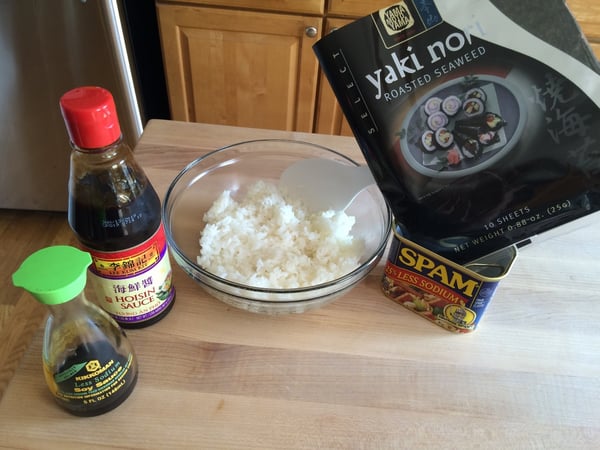 The preparation is pretty easy. Start by cooking your rice while you prep your other ingredients, and then transfer it to a bowl when it’s done so it can cool for easier handling. To prepare your sauce, simply mix together the hoisin and soy sauce in a bowl and set aside. I didn’t have any teriyaki sauce at the time of making this, but a thicker, bottled teriyaki sauce is a great option here as well, or you can even make your own teriyaki sauce. Next, cut your nori sheets in half the long way.
The preparation is pretty easy. Start by cooking your rice while you prep your other ingredients, and then transfer it to a bowl when it’s done so it can cool for easier handling. To prepare your sauce, simply mix together the hoisin and soy sauce in a bowl and set aside. I didn’t have any teriyaki sauce at the time of making this, but a thicker, bottled teriyaki sauce is a great option here as well, or you can even make your own teriyaki sauce. Next, cut your nori sheets in half the long way.
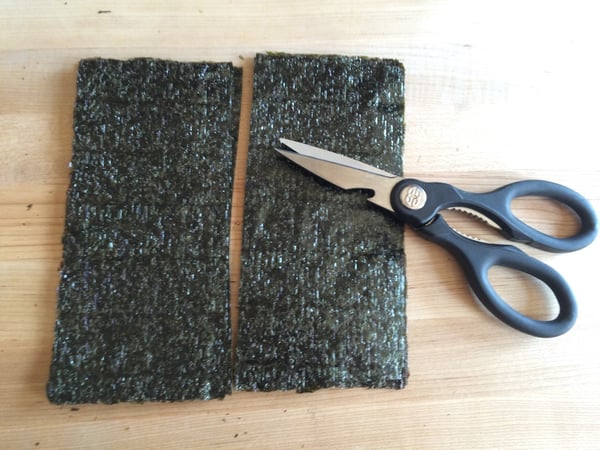 Next, shake that scrumptious slab of spam out of its can and cut into 8 slices.
Next, shake that scrumptious slab of spam out of its can and cut into 8 slices.
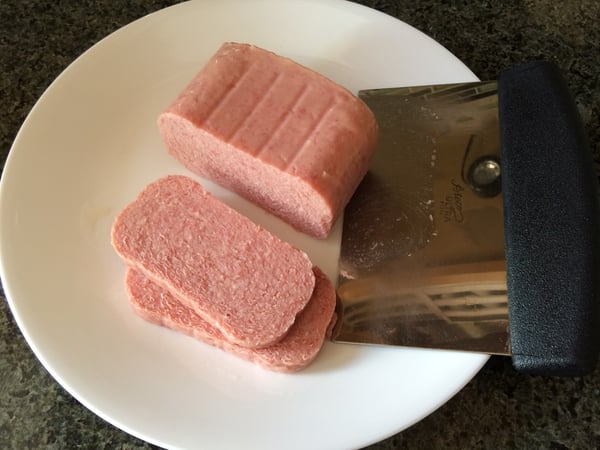 Once your mise en place is ready to go, heat up a non-stick pan and start searing those slices of spam. No oil is really needed in this step since the spam itself has enough fat to keep from sticking to the pan and to get a nice sear. Once it’s golden brown, flip and do the same on the other side.
Once your mise en place is ready to go, heat up a non-stick pan and start searing those slices of spam. No oil is really needed in this step since the spam itself has enough fat to keep from sticking to the pan and to get a nice sear. Once it’s golden brown, flip and do the same on the other side.
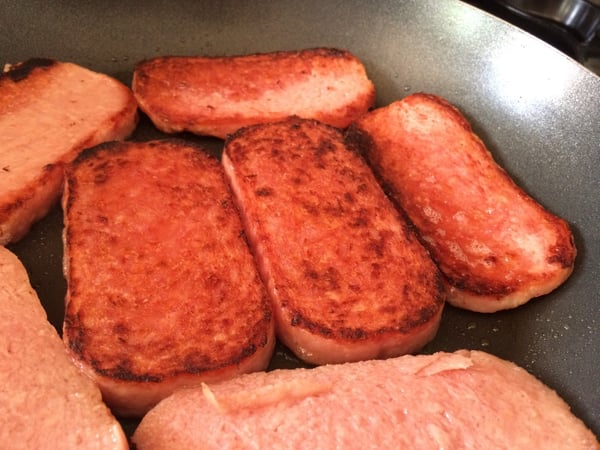
Now you can start assembling your spam musubi! At this stage, it is helpful to have a small bowl of water on hand that you can dip your fingers into in order to keep the rice from sticking to your hands as you work with it.
Start by laying the shiny side of your nori facedown. The rice will adhere better to the rough side. Wet your fingers, grab a small handful of rice, and form it into a rectangle on your nori, leaving about ½ inch of the nori exposed at the bottom. Once the rice is formed to a shape about the size of one of your spam slices, drizzle some of your sauce mixture over the rice, and then place a piece of the seared spam on top.
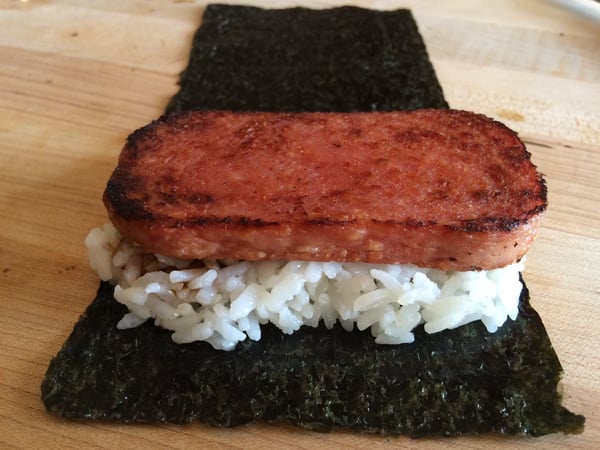 From here, start by folding up the smaller exposed edge of the nori, then roll up the musubi the rest of the way. You only need about ½ inch of overlap on the nori, so cut off any excess, then wet the nori at the end to help it adhere at the overlap. Now you can simply enjoy! You can dip the spam musubi in any excess sauce you might have, or just eat it straight. You can also adjust the sauce and spam-to-rice ratios to your liking.
From here, start by folding up the smaller exposed edge of the nori, then roll up the musubi the rest of the way. You only need about ½ inch of overlap on the nori, so cut off any excess, then wet the nori at the end to help it adhere at the overlap. Now you can simply enjoy! You can dip the spam musubi in any excess sauce you might have, or just eat it straight. You can also adjust the sauce and spam-to-rice ratios to your liking.
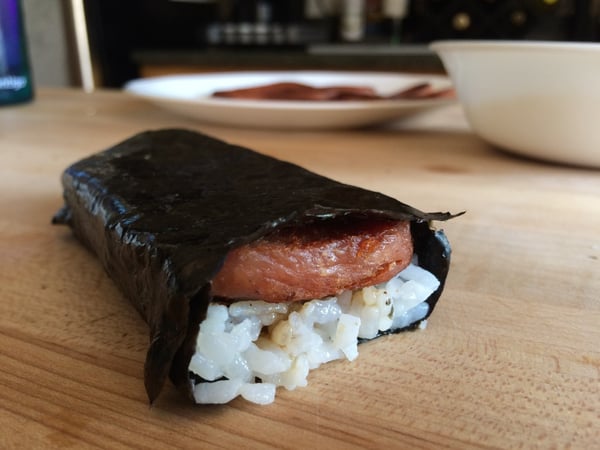 Now that we’re smack dab in the middle of the country, Hawaiian fare isn’t as easy to come by, although it’s not an entirely lost cause. You can get a little taste of Hawaiian BBQ here in Chicago at one of my favorite, hearty fast food stops, Aloha Eats. In line with tradition, the barbecued meats are served with a side of rice and a scoop of macaroni salad, but of course they also have the salty treat, spam musubi.
Now that we’re smack dab in the middle of the country, Hawaiian fare isn’t as easy to come by, although it’s not an entirely lost cause. You can get a little taste of Hawaiian BBQ here in Chicago at one of my favorite, hearty fast food stops, Aloha Eats. In line with tradition, the barbecued meats are served with a side of rice and a scoop of macaroni salad, but of course they also have the salty treat, spam musubi.
Another way to enjoy some cuisine of the Pacific Islands here in Chicago is to join us for The Chopping Block’s upcoming Tiki Time cooking class!












